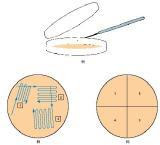Ziehl-Neelsen (Hot Stain) Procedure
Kinyoun (Cold Stain) Procedure
(This may be used instead of or in addition to the Ziehl-Neelsen procedure.)
- Prepare a smear consisting of a mixture of E. coli and M. smegmatis.
- Allow the smear to air dry and then heat-fix (see figure 7.1).
- Place the slide on a hot plate that is within a chemical hood (with the exhaust fan on), and cover the smear with a piece of paper towelingthat has been cut to the same size as the microscope slide. Saturate the paper with Ziehl’s carbolfuchsin (figure a). Heat for 3 to 5 minutes. Do not allow the slide to dry out, and avoid excess flooding! Also, prevent boiling by adjusting the hot plate to a proper temperature. A boiling water bath with a staining rack or loop held 1 to 2 inches above the water surface also works well. (Instead of using a hot plate to heatdrive the carbolfuchsin into the bacteria, an alternate procedure is to cover the heat-fixed slide with a piece of paper towel. Soak the towel with the carbolfuchsin and heat, well above a Bunsen burner flame.)
- Remove the slide, let it cool, and rinse with water for 30 seconds (figure b).
- Decolorize by adding acid-alcohol drop by drop until the slide remains only slightly pink. Thisrequires 10 to 30 seconds and must be done carefully (figure c).
- Rinse with water for 5 seconds (figure d).
- Counterstain with alkaline methylene blue for about 2 minutes (figure e).
- Rinse with water for 30 seconds (figure f).
- Blot dry with bibulous paper (figure g).
- There is no need to place a coverslip on the stained smear. Acid-fast organisms stain red; the background and other organisms stain blue or brown.
Kinyoun (Cold Stain) Procedure
(This may be used instead of or in addition to the Ziehl-Neelsen procedure.)
- Heat-fix the slide as previously directed.
- Flood the slide for 5 minutes with carbolfuchsin prepared with Tergitol No. 7 (heat is not necessary).
- Decolorize with acid-alcohol and wash with tap water. Repeat this step until no more color runs off the slide.
- Counterstain with alkaline methylene blue for 2 minutes. Wash and blot dry.
- Examine under oil. Acid-fast organisms stain red; the background and other organisms stain blue.





